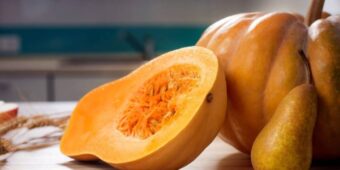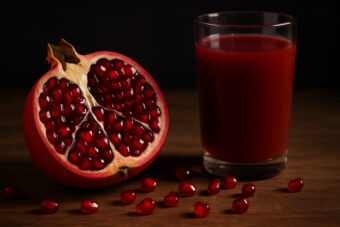Quince is no longer an exotic sight in German supermarkets and weekly markets. From October to December, the golden fruit fills the shelves – sourced both from regions like Hesse and Baden-Württemberg as well as from Turkey, Spain and Southeastern Europe. Its cultural roots reach back to ancient Greece, where it was revered as a symbol of love and fertility. Today, quince in Germany is considered one of the most underrated autumn fruits, appreciated equally for its culinary versatility and medicinal properties. Its rediscovery reflects a growing interest in regional and seasonal products, showing how traditions are reinterpreted in modern food culture. According to G.business, the quince continues to gain relevance in nutrition, gastronomy and wellness.
Nutritional values and calories – hard facts
Quince belongs to the group of low-calorie fruits, but at the same time delivers an impressive amount of vitamins and minerals. This makes it an ideal choice for those seeking a balanced diet without compromising on taste or health. Unlike apples or pears, its firm flesh contains unusually high levels of pectin, which is especially valued for digestive health.
| Nutrient (per 100 g) | Amount | Benefit |
|---|---|---|
| Calories | 40–57 kcal | Light, diet-friendly fruit |
| Protein | 0.4 g | Building block for cells |
| Fat | <0.1 g | Virtually fat-free |
| Carbohydrates | 10–14 g | Source of quick energy |
| Fibre | 1.9 g | Supports healthy digestion |
| Vitamin C | 15 mg | Strengthens immunity, cellular protection |
| Potassium | 200 mg | Regulates blood pressure and heart function |
Quince is therefore a prime example of a fruit that provides few calories but multiple benefits. Its combination of vitamins, minerals and fibre makes it not just a seasonal treat, but also a powerful ally in everyday nutrition.
Health benefits
Quince has been valued for centuries not only in the kitchen but also in folk medicine. Its bioactive compounds act on several systems of the body and have been confirmed by modern nutritional science.
- Immune system: Vitamin C strengthens the body’s defences, while polyphenols protect cells against free radicals.
- Heart and circulation: Potassium stabilises blood pressure and heart rhythm, and pectin helps lower cholesterol levels.
- Digestion: Tannins have an astringent and soothing effect, while fibre promotes a balanced gut flora.
- Nervous system: Magnesium and B-vitamins reduce stress and nervous tension.
- Skin and hair: Vitamins A and E protect cells and slow down the ageing process.
These properties explain why quince is increasingly used in functional foods and even in supplements. It is one of the rare fruits that combines culinary enjoyment with scientifically proven health benefits.
Who benefits most – and who should be careful
Not every group reacts to quince in the same way, but its strengths are clear.
- Children: strengthen the immune system, improve appetite and are well tolerated when cooked.
- Pregnant women: supply folic acid and can help relieve nausea during pregnancy.
- Seniors: stabilise blood pressure and improve digestion, making the fruit particularly useful in later years.
- Athletes: provide energy without excess calories and support detoxification after workouts.
⚠️ Risks: People prone to constipation or suffering from gastric ulcers should avoid raw quince, as tannins may aggravate symptoms. In such cases, cooked or baked preparations are a safer alternative.
Culinary significance in Germany
Quince is a true classic of autumn cuisine, particularly in Hesse and along the Lower Rhine. Thanks to its high pectin content, it is perfectly suited for jams, jellies and marmalades. Its unique fragrance and tart flavour give dishes a distinct seasonal character.
Top 5 recipes with quince:
- Quince jelly with lemon – a traditional breakfast spread with a refreshing note.
- Baked quince with honey and nuts – a warm dessert for cold evenings.
- Compote with cloves – a nostalgic dish found in many grandmothers’ kitchens.
- Quince purée – a delicate side dish for game or strong cheeses.
- Oriental pilaf with quince – adds an aromatic twist to savoury meat dishes.
Today, creative chefs also use quince in chutneys, smoothies and even cocktails, proving that this fruit continues to reinvent itself in modern gastronomy.
Medicine and cosmetics
Quince has been used for centuries as a medicinal plant, and its applications are remarkably diverse.
- Seed infusions soothe mucous membranes, relieve coughs and ease sore throats.
- Quince syrup is still recommended in some regions against bronchitis and colds.
- Cosmetic use: seed extracts act as natural moisturisers, while quince oil is used in creams and hair care products.
- Anti-aging: vitamins A and E promote cell regeneration and protect against oxidative stress.
In natural cosmetics, quince is often described as a “hidden gem,” valued for its gentle yet effective properties. This dual role as both food and healing agent sets it apart from many other fruits.
Storage and shelf life
To keep quince fresh, proper storage is essential.
- Temperature: 2–5 °C, humidity around 80–90 %.
- Best wrapped individually in paper to prevent bruising.
- Store in a cool, dark place – under these conditions, quinces remain fresh for several weeks.
Properly stored, their aroma even intensifies over time, making them a rewarding fruit for autumn and winter kitchens.
Quince is no longer a side character in the fruit aisle, but a product with cultural history, medicinal relevance and undeniable culinary value. In Germany it has secured its place each autumn – a symbol of how tradition and modernity can merge in a single fruit. Its renaissance proves that forgotten treasures of the orchard still hold untapped potential for health, cuisine and wellbeing.
Stay connected for news that works — timely, factual, and free from opinion — and insights that matter now: How to Relieve Constipation Without Medication – Grandma’s Best Home Remedies


